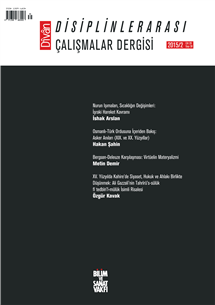39
İşraki hareket kavramından Deleuze'ün Bergson'la olan fikri münasebetine, Türkiye'de asker anılarından XV. yüzyılda Kahire'de şer'î siyasete, Şihabüddin Yahya Sühreverdi'den Ali Gazzali'ye uzanan bir düşünce yolculuğu olarak hazırlanan Dîvân'ın 39. Sayısı okurlarının ilgisini bekliyor. Bu sayı üç telif makale, bir araştırma notu ve yedi kitap değerlendirme yazısını kapsamaktadır.
Articles
Through its light (nur)-based ontology, magnitude (miqdar)-based theory of matter, and mystical intuition (dhawq)-based methodology, Illuminationist (Ishraqi) philosophy had emerged as a self-contained philosophical system by the twelfth century. This article examines the Ishraqi formulation of the problem of motion a coherent solution to which is expected from any complete philosophical system as laid out in Yahya al-Suhrawardis (1154-1191) Illuminationist masterpiece, Hikmat al-Ishraq. The way the Ishraqi system interprets motion, as purifying the physical body of all qualitative, substantive features and reducing it to a collection of nonessential attributes, is analyzed in comparison with the Peripatetic theory of motion. This article discusses the Ishraqi account of the problem of motion with respect to its definition of motion, its account of its source, and the particular solutions it offers and the degree to which it offers a coherent model. According to the Ishraqi system, the circular motion of abstract lights is associated directly with the emanation (ishraq) of the Light of Lights, and the motion of physical bodies in the process of becoming and decay is explained as the synchronic reflection of immaterial lights (anwar mujarrada) on the realm of magnitudes (maqadir/bodies). The problem of the connection between light and magnitude is solved through the concept of heat (harara). This article argues that the Ishraqi theory of motion contains novel elements that touch on many problems, ranging from human psychology to the theory of knowledge, and thus that it cannot be considered as merely the continuation of the Avicennian tradition.
İshak ARSLANDeleuzes relationship with Bergson was not merely a French philosophers academic interest in his own tradition, but also an encounter creating unexpected possibilities and an event generating new truths. This article presents an account of Deleuzes reading of Bergson and shows how Deleuze used Bergson to produce a re-reading of philosophy and cinema, detailing Deleuzes references to Bergson in a chronological manner. Against those who viewed Bergson as a vitalist, spritualist philosopher, Deleuze generated a new materialist ontology based on Bergsons notion of virtuality. Deleuze brought Bergson to bear on the needs of present by reclaiming him from his virtual state in the past. But every such effort is also an interpretive act. For this reason, prior to discussing how Deleuze re-read Bergson in accordance with his own needs, this paper begins by offering a portrait of Bergson based on his own writings. It then turns to an examination of Deleuzes work, with special attention to how his philosophy of cinema depends on Bergsons concept of image. Writing against a Hegelian tradition of progressive, dialectical difference based on negation, Bergson offered an account of virtual multiplicity that affirmed difference. This paper argues that Deleuze used Bergons theory to develop an original ontology that provided new possibilities for understanding multiplicity, becoming, and difference, as well as a non-subject-centered theory of consciousness and philosophy of cinema.
Metin DEMİRVarious considerations exist in the literature about the author of Tahrir al-Suluk fi Tadbir al-Muluk, a treatise written in Cairo during the Mamluk era containing both political and judicial provisions. The Tahrir was first published by Fuad Abd al-Muim Ahmad, who cited Abu al-Fadl Muhammad al-Araj (d. 1519) as the original author. This study argues that Abd al-Muim Ahmad misidentified the author of the treatise, and that it was actually written in 1454 by Ali b. Muhammed al-Gazzali (d.1473/74), who passed away 50 years before al-Arec. The Tahrir consists of four main parts: the prologue, introduction, main part, and conclusion. The prologue deals with the importance and responsibilities of the ruler, while the introduction addresses his ethical qualities. The main part, the longest section of the study, focuses on the issue of injustice (mazalim). The conclusion attempts to place the acts of the caliph regarding criminal law into an Islamic framework. The treatise analyzes decrees about procedures for judicial rulings, with an eye to the conditions of the period, and uses this analysis as the basis for describing the position of political authority. Additionally, it discusses possible ways of applying the sharia in cases that exceed judges responsibility, authority, or ability. Ali al-Gazzali divides these decrees into two types, according to who carries them out. Judges apply judicial decrees (ahkam), while rulers apply political ones (siyasa). Sharia is thus presented as a higher category encompassing both ahkam and siyasa. The treatise deserves special attention for emphasizing this distinction, which traces back to al-Mawardi (d. 1058), and bringing it once again to the fore in fifteenth-century Cairo.
Özgür KAVAKThis study examines the life narratives (memoirs, autobiographies, journals, letters, etc.) of soldiers in Turkey written in the nineteenth and twentieth centuries. Although in recent decades there has been a significant increase in the amount of research on the military in Turkey, the field remains understudied. This study attempts to focus on the life narratives of soldiers written by soldiers themselves as a way of highlighting their potential value for understanding the roles and actions of the military. Since life narratives are relatively free vehicles for the expression of personal thoughts, these texts present a more human, direct, and authentic data set than do official or institutional statements. Because of this characteristic, these texts have the capacity to enrich the existing literature on the relations between military, society, and politics in Turkey. This study offers a survey of the relevant literature, followed by some general and qualitative remarks about the subject corpus and an analysis of more than 150 life-narratives written by soldiers at several ranks (from military students to marshals). It also discusses the motivation behind the act of writing, the promises of life-narrative, general themes within such texts, and the general cultural climate of the works in the corpus.
Hakan ŞAHİN





